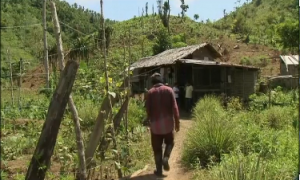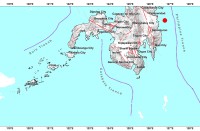
(Reuters) — A year after Typhoon Haiyan tore through central Philippines, coconut farmers whose livelihoods were destroyed in the disaster have turned to alternative sources of work.
Typhoon Haiyan wiped out or damaged practically everything in its path as it swept ashore on Nov. 8, 2013, with seven-metre storm surges destroying around 90 percent of the city of Tacloban in Leyte province.
Haiyan killed or left missing close to 8,000 people and displaced as many as four million.
Local farmers usually harvest coconut trees, but after Haiyan left a trail of destruction, the farmers at a rural village in the mountains west of Tacloban City are growing vegetables, such as corn and cabbage, to earn money. They are waiting for the coconut trees planted earlier this year to mature, a process that can take between seven to 10 years.
International aid group, Oxfam country Director Justin Morgan said income levels had not recovered a year on.
“Within the jobs sectors, a lot of the time we’re seeing that in the coconut industry, as well as in the fishing industry, that many of the people are not back to the same levels of income which they had prior to the typhoon, and they were often amongst the members of the community as well, so they’re suffering a second time around,” Morgan said.
Farmer Herminia Ranes has sold vegetables on her two hectare field, which brings in a smaller income, while she waits for the coconut seedlings she received from the national government to mature.
“Farming vegetables is the only source of livelihood we have right now. If we cannot plant vegetables for even a week, it would be difficult. That’s why we have to plant, plant and plant to recover.” she said.
Some farmers have made use of the lumber from the damaged coconut trees to earn about 70 pesos (1.6 USD) per piece. Others have left their farming life to participate in alternative livelihood programmes being offered by aid groups.
The U.N.’s International Labor Organization (ILO) said nearly 6 million people had lost their jobs immediately after the typhoon – mostly retailers, service crew, coconut farmers and fishermen. While some have found alternative means to earn a living, for most of the typhoon victims, a more sustainable livelihood is still far from sight, ILO said.
The eastern Visayas region was one of the country’s top producers of coconuts. Government data showed 16 million coconut trees were damaged by the typhoon.
The government has allocated 34 billion pesos (76 million USD) from its 168 billion pesos (3.74 billion USD) six-year master plan on livelihood assistance, which include a rehabilitation of coconut plantations and cash assistance for more than 705,000 farmers.
The Philippines, which sees an average of 20 typhoons a year, is planning to build typhoon-resilient structures and to relocate residents living in danger zones to areas considered safer based on studies by local and international organisations.
The government has released about 51.9 billion pesos ($1.15 billion) for the initial recovery work.







